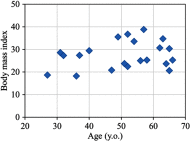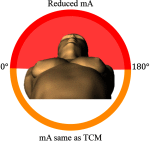Breast dose reduction with organ-based, wide-angle tube current modulated CT
- PMID: 28804730
- PMCID: PMC5544175
- DOI: 10.1117/1.JMI.4.3.031208
Breast dose reduction with organ-based, wide-angle tube current modulated CT
Abstract
This study aimed to estimate the organ dose reduction potential for organ-dose-based tube current modulated (ODM) thoracic computed tomography (CT) with a wide dose reduction arc. Twenty-one computational anthropomorphic phantoms (XCAT) were used to create a virtual patient population with clinical anatomic variations. The phantoms were created based on patient images with normal anatomy (age range: 27 to 66 years, weight range: 52.0 to 105.8 kg). For each phantom, two breast tissue compositions were simulated: [Formula: see text] and [Formula: see text] (glandular-to-adipose ratio). A validated Monte Carlo program (PENELOPE, Universitat de Barcelona, Spain) was used to estimate the organ dose for standard tube current modulation (TCM) (SmartmA, GE Healthcare) and ODM (GE Healthcare) for a commercial CT scanner (Revolution, GE Healthcare) using a typical clinical thoracic CT protocol. Both organ dose and [Formula: see text]-to-organ dose conversion coefficients ([Formula: see text] factors) were compared between TCM and ODM. ODM significantly reduced all radiosensitive organ doses ([Formula: see text]). The breast dose was reduced by [Formula: see text]. For [Formula: see text] factors, organs in the anterior region (e.g., thyroid and stomach) exhibited substantial decreases, and the medial, distributed, and posterior region saw either an increase of less than 5% or no significant change. ODM significantly reduced organ doses especially for radiosensitive superficial anterior organs such as the breasts.
Keywords: computed tomography; organ dose; organ dose based tube current modulation; tube current modulation.
Figures








Similar articles
-
Technical Note: Phantom study to evaluate the dose and image quality effects of a computed tomography organ-based tube current modulation technique.Med Phys. 2015 Nov;42(11):6572-8. doi: 10.1118/1.4933197. Med Phys. 2015. PMID: 26520748
-
Convolution-based estimation of organ dose in tube current modulated CT.Phys Med Biol. 2016 May 21;61(10):3935-54. doi: 10.1088/0031-9155/61/10/3935. Epub 2016 Apr 27. Phys Med Biol. 2016. PMID: 27119974 Free PMC article.
-
CT breast dose reduction with the use of breast positioning and organ-based tube current modulation.Med Phys. 2017 Feb;44(2):665-678. doi: 10.1002/mp.12076. Med Phys. 2017. PMID: 28032894
-
Prospective estimation of organ dose in CT under tube current modulation.Med Phys. 2015 Apr;42(4):1575-85. doi: 10.1118/1.4907955. Med Phys. 2015. PMID: 25832048 Free PMC article.
-
Dose to radiosensitive organs during routine chest CT: effects of tube current modulation.AJR Am J Roentgenol. 2009 Nov;193(5):1340-5. doi: 10.2214/AJR.09.2886. AJR Am J Roentgenol. 2009. PMID: 19843751 Free PMC article.
Cited by
-
A comparison of breast and lung doses from chest CT scans using organ-based tube current modulation (OBTCM) vs. Automatic tube current modulation (ATCM).J Appl Clin Med Phys. 2021 May;22(5):97-109. doi: 10.1002/acm2.13198. Epub 2021 May 3. J Appl Clin Med Phys. 2021. PMID: 33939253 Free PMC article.
-
A scanner-specific framework for simulating CT images with tube current modulation.Phys Med Biol. 2021 Sep 13;66(18):10.1088/1361-6560/ac2269. doi: 10.1088/1361-6560/ac2269. Phys Med Biol. 2021. PMID: 34464942 Free PMC article.
-
Advances in radiation protection related to pediatric chest computed tomography examinations.World J Radiol. 2025 Jul 28;17(7):107486. doi: 10.4329/wjr.v17.i7.107486. World J Radiol. 2025. PMID: 40746519 Free PMC article. Review.
-
Advances in Computational Human Phantoms and Their Applications in Biomedical Engineering - A Topical Review.IEEE Trans Radiat Plasma Med Sci. 2019 Jan;3(1):1-23. doi: 10.1109/TRPMS.2018.2883437. IEEE Trans Radiat Plasma Med Sci. 2019. PMID: 30740582 Free PMC article.
References
-
- IMV, CT Market Outlook Report IMV Medical Information Division, Des Plaines, Illinois: (2014).
-
- Valentin J., The 2007 Recommendations of the International Commission on Radiological Protection, Elsevier, Oxford: (2007).
LinkOut - more resources
Full Text Sources
Other Literature Sources

